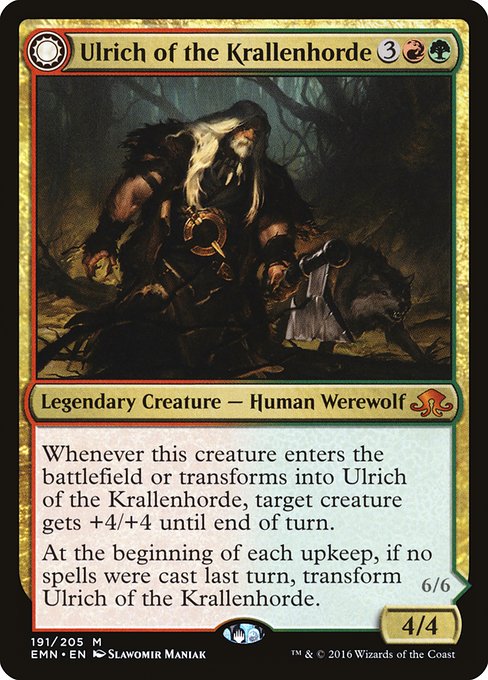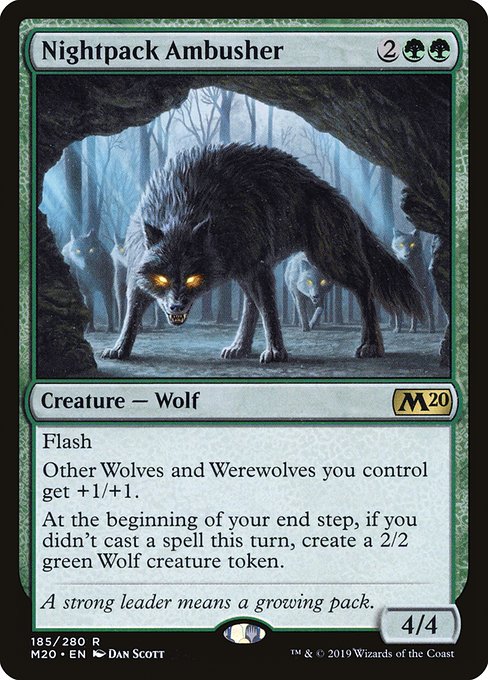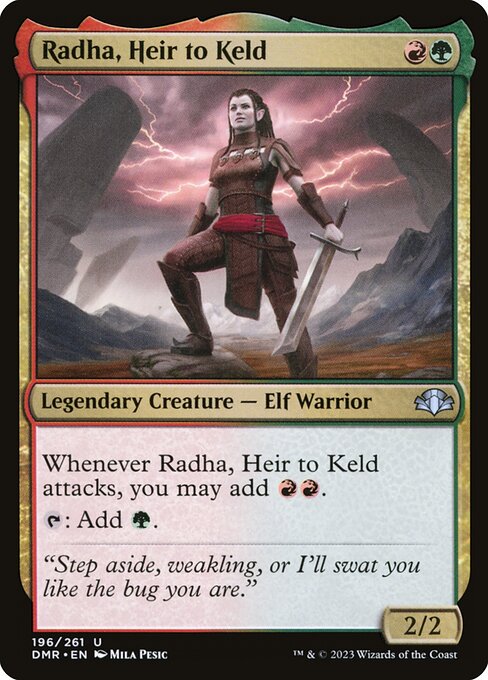In 2011, the Magic world was introduced of Innistrad. With a dark, grim theme, it featured all sorts of classic gothic horror tropes. Among all the memorable evocations of the genre, arguably nothing felt more flavorful than seeing the townsfolk of Innistrad turn evil under a full moon. Playing a deck full of werewolves was a varied and exciting experience. And yet, werewolf decks haven’t yet found a place in Commander. Today, we’ll get into what holds werewolves back, what we can do about it now, and where we might go in the future.
Where the Pack Sits Now
For all intents and purposes, playing Werewolves in Commander is like having a ship without a captain. Innistrad block was designed before Commander was really popular, and so saw only eleven playable legends in the entire block—none of which cared about werewolves. Shadows Over Innistrad brought us another chance for a werewolf commander, but we whiffed again. Yes, Ulrich of the Krallenhorde does exist, but he might as well not. Ulrich was meant for Limited, and barely creates any werewolf synergy at the helm of a Commander deck. We simply can’t rely on such an ineffectual leader, especially in a world of value engine decks.

On the recent stream for Commander Legends, the Wizards of the Coast design team mentioned that there will be no double-faced cards in the set. This effectively removes the chance of a legendary werewolf showing up in the set. They commented that a werewolf commander is on their list, though, so we do have a glimmer of hope. The challenge here is that we have to improvise. At their core, werewolves make for exciting one-on-one gameplay. Their transform ability punishes inaction from the opponent, allowing the werewolf player to apply steady pressure. They can scale well into the late game too, when players are running out of cards and casting fewer spells. But werewolves don’t scale well into multiplayer.
It’s a harsh truth, but with two extra opponents, there are now three times as many chances to have them flip back to their docile, human selves. This makes for wildly unreliable play patterns. With how long Commander games run, it’s very easy to see players put out two or three spells per turn. We could see our team flip back and forth twice, before we even have a chance to attack again. In the meantime, we’re hoping to draw into Moonmist, the only card that can flip all of our werewolves at once. Until then, we’re left attacking with underpowered creatures. Our wolfpack needs a lot of work, if we’re going to try and make it in Commander.
Feed the Pack
Werewolves need a multifaceted legend to lead the pack. It should not only buff the team, but also provide some other benefits. Kumena, Tyrant of Orazca and General Kudro of Drannith are great examples of this. They offer both static and activated abilities, allowing the player to adapt to a variety of game states. To make it more werewolf-specific, we might want to see an effect like Geier Reach Bandit, where our werewolves are transformed on entry. We could see some kind of punishment effect, like that on Ruric Thar, the Unbowed.
While we’ve seen “wolves matter” cards in Selesnya, like Tolsimir, Friend to Wolves, we’re looking at a primarily Gruul deck. There may be a Naya werewolf/wolf legend someday, like how Nightpack Ambusher cares about both, but that seems less likely than a two-color option. From the color pie perspective, menacing, murderous beasts aren’t necessarily found in White.

Unsurprisingly, werewolves lack a critical mass of lord effects. However, +1/+1 effects in nontoken decks can only get us so far. In my article about playing Humans in Commander, I pointed out that cards like Heron’s Grace Champion simply don’t cut it anymore. Instead, we have new designs like Jirina Kudro, which scales better for the higher life totals in Commander. Our werewolf lords, on the other paw hand, are still largely stuck in the lens of two-player Magic. We’re looking at the likes of Immerwolf, Nightpack Ambusher, and Arlinn, Voice of the Pack. After those, we rely on a hodgepodge of small-scale options like Full Moon’s Rise, Howlpack Resurgence, and Mayor of Avabruck.
As for other support cards, we have to address the fickle nature of Transform. In order to keep up, we need more ways to manage when our team flips. We need more ways to keep them flipped, so we’re not punished by spell-heavy decks like Kalamax, the Stormsire. This could be as easy printing more riffs on Moonmist and Immerwolf. With Ruthless Regiment giving Humans a sacrifice subtheme, we could see some new design space explored for werewolves.
On a more abstract note, we could see cards that punish players for playing more than one spell. That would allow us to potentially dissuade players from having spell-heavy turns that flip our werewolves back. While Eidolon of Rhetoric and Ethersworn Canonist belong to White, we might see a damage-based effect out of Red. Mondronen Shaman is an example of this, and it could be expanded into werewolf versions of Harsh Mentor and Ash Zealot. Cult of the Waxing Moon rewards transformation into werewolves, but we could use a big payoff for when your team is forced to change back. Ulrich of the Krallenhorde and Huntmaster of the Fells have singular effects, but to scale into multiplayer, we need to go bigger.
The Unlikely Alpha
So, what if I told you that we have a decent commander option already in the card pool? It’ll take a Rule Zero conversation, but if your playgroup is okay with it, give Immerwolf a try. Until we get a bonafide legend that works well with werewolves, Immerwolf (who we desperately need new art for) is our best chance for mitigating the transformation problem. All it takes is Lightning Greaves or Swiftfoot Boots, and we can start comfortably building our werewolf pack. At three mana, you can rest assured that you can re-cast it a few times over the course of the game, if you have to.
To get us started, here’s a basic list I built up for Immerwolf. One of the biggest challenges is in mitigating the variance of Transform, so we have to brew carefully. We’re trying to keep our creatures transformed, so if we don’t have our commander out, we remove that built-in handicap. I looked more towards permanents with activated abilities. If untap with flipped werewolves, then we have things to do on our turn without potentially flipping them back. Speaking from experience, though, it’s rarely a good idea to play zero spells on your turn, just to flip your werewolves. Someone could Brainstorm on your end step, which means you’ve thrown your turn away.
This list is still a prototype, so it’ll evolve as I get some games with it. While I’m optimistic about it now, I may run into more of the aforementioned problems.
Imprisoned Under the Moon
If you’d rather play with an existing legendary creature, or kick things up a notch in general, then let’s go for a walk down the Kessig Wolf Run. While our creature options are limited, we do have plenty of things to keep people from casting spells, let alone do anything at all. So with that, I give you Radha, Heir to Keld Werewolf Stax. Whereas the Immerwolf deck is fine for casual circles, this one requires the conversation of “Will you have fun playing against this?” For some added context, I gave myself no budget with this deck, as a “proof of concept” exercise of making a werewolf deck as strong as possible. There are plenty of budget alternatives for things like lands and fast mana.

The goal of werewolf stax is simple: keep our opponents from casting spells, so that our werewolves don’t flip back. Radha, Heir to Keld is our commander solely as a mana creature in the command zone. Her built-in mana generation allows us to get under various stax pieces. We’re punishing mana with cards like Blood Moon, Hall of Gemstone, and Winter Orb. Since our werewolves are four mana and under, we don’t need a lot of lands to make this deck operate. So, we can afford mass land destruction like Ruination and Impending Disaster.
To protect ourselves without countermagic, we have to get creative. Since most of our creatures don’t have ETB effects, we can comfortably play Torpor Orb. It shuts down the likes of Reclamation Sage and Acidic Slime, giving our stax pieces a better chance of survival. That also works well against decks that use Chord of Calling or Birthing Pod to get their answers out. Another defense against countermagic is cutting opponents off from those answers in the first place. Price of Glory, City of Solitude, and Defense Grid can punish, lock, or tax our opponents out of responses.
We’re going to assemble this rickety collection of stax pieces, and ride a few werewolves to victory. Will it work? Who knows, seeing that I haven’t tested this list out. I can’t guarantee that your playgroup will love it, but as long as you have a conversation with them beforehand, then go for it.
Howling at the Moon for a Playable Werewolf Deck
We werewolf fans have to be patient. The deck isn’t playable outside of the more casual circles, and we need a lot of things to get it to a higher level. For those reasons, I don’t think just one legendary creature will fix our problems. I think we need a bona fide werewolf preconstructed deck that has the space to create 10-15 new cards that benefit the pack. Seeing how Humans got cards like Bastion of Remembrance, Species Specialist, and Fireflux Squad, we could see that idea applied to Werewolves. Just like how monowhite needs systemic changes to improve, we need the same thought process applied here.
So, I’ll make the shot call here: we’ll have a preconstructed werewolf Commander deck within the next two years. Wizards has shown that they can make a tribal deck alongside themes like Mutate and Cycling, so we could definitely see it for this underserved, but deserving creature type. Someday, the wolfpack will be a force to be reckoned with. Until then, I’ll keep asking “Wait, did you play any spells that turn?”
Travis is a Virginia-based player and writer, who has been turning things sideways since Starter 1999. He primarily plays Commander, Pauper, and Legacy, and has a passion for introducing new players to the game. When he isn’t making people pay the Thalia tax, he can be found mountain biking or playing the guitar. You can follow his exploits here on Twitter and Instagram.

